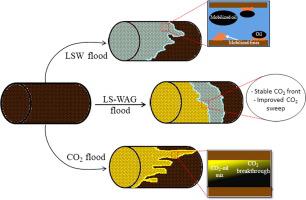当前位置:
X-MOL 学术
›
Chem. Eng. Sci.
›
论文详情
Our official English website, www.x-mol.net, welcomes your
feedback! (Note: you will need to create a separate account there.)
Investigating Synergy of CO2 and Low Saline Water for CO2 Storage and Enhanced Oil Recovery
Chemical Engineering Science ( IF 4.1 ) Pub Date : 2021-01-01 , DOI: 10.1016/j.ces.2020.116127 Krishna Raghav Chaturvedi , Durgesh Ravilla , Waquar Kaleem , Prashant Jadhawar , Tushar Sharma
Chemical Engineering Science ( IF 4.1 ) Pub Date : 2021-01-01 , DOI: 10.1016/j.ces.2020.116127 Krishna Raghav Chaturvedi , Durgesh Ravilla , Waquar Kaleem , Prashant Jadhawar , Tushar Sharma

|
Abstract CO2 utilization for oil recovery applications is often impacted by the challenges such as viscous fingering and its premature breakthrough. Injection of slugs of water-alternating-gas (WAG) generally aims to overcome these challenges though the control of CO2 mobility. Moreover, the oil recovery potential of WAG is largely dependent on the injection water salinity and the subsequent CO2 dissolution and storage. Therefore, the effect of varying salinity (0–4 wt% NaCl) on CO2 loading capacity of water is investigated in this study, at two test temperatures of 323 K and 363 K and three confining pressures of 4, 8, and 12 bar, and subsequently, the flooding experiments were performed to find the low salinity (LS)-WAG process suitability in oil recovery applications from porous sandstone rocks. The inclusion of salt was found to significantly affect CO2 loading capacity of water. At higher NaCl concentration (4 wt%), CO2 loading decreased by 50% as demonstrated by absorption kinetic study. LS-WAG suggested maximum oil recovery 55–58% of original oil in place for water salinity of 2 wt% NaCl at both the test temperatures. Increment in pressure had a positive impact on CO2 loading while increasing temperature showed reverse behavior. As a result of LS in WAG and kinetic adsorption study, it is anticipated that the reduction in water salinity is a favorable factor in the CO2 storage and oil recovery performance of CO2 injection. The instance of CO2 injection was also varied for LS-WAG process and its effect on oil recovery from sand-packs was reported. Oil recovery results demonstrated that WAG was similarly effective in all the stages of the injection cycle as long as water salinity remained lower than 2 wt% NaCl. Based on the findings in this study, it is recommended to implement the WAG in conjunction with low salinity water (LSW) in moderate saline conditions, which is of key importance for various applications where water salinity differs on a large scale.
中文翻译:

研究 CO2 和低盐水协同作用用于 CO2 封存和提高石油采收率
摘要 石油采收应用中的二氧化碳利用经常受到诸如粘性指法及其过早突破等挑战的影响。注入水交替气体 (WAG) 段塞通常旨在通过控制 CO2 流动性来克服这些挑战。此外,WAG 的采油潜力在很大程度上取决于注入水的盐度和随后的 CO2 溶解和储存。因此,本研究在 323 K 和 363 K 的两个测试温度和 4、8 和 12 巴的三个围压下研究了不同盐度(0-4 wt% NaCl)对水的 CO2 负载能力的影响,随后,进行了驱油实验,以发现低盐度 (LS)-WAG 工艺在多孔砂岩采油应用中的适用性。发现包含盐会显着影响水的 CO2 负载能力。吸收动力学研究表明,在较高的 NaCl 浓度 (4 wt%) 下,CO2 负载量降低了 50%。LS-WAG 建议在两个测试温度下,对于 2 wt% NaCl 的水盐度,原油的最大采油率为 55-58%。压力增加对 CO2 负载有积极影响,而温度升高则表现出相反的行为。作为 WAG 中的 LS 和动力学吸附研究的结果,预计水盐度的降低是 CO2 注入的 CO2 存储和采油性能的有利因素。LS-WAG 工艺的 CO2 注入情况也有所不同,并报告了其对从砂层中采油的影响。采油结果表明,只要水的盐度保持低于 2 wt% NaCl,WAG 在注入周期的所有阶段都同样有效。根据本研究的结果,建议在中等盐度条件下结合低盐度水 (LSW) 实施 WAG,这对于水盐度大范围不同的各种应用至关重要。
更新日期:2021-01-01
中文翻译:

研究 CO2 和低盐水协同作用用于 CO2 封存和提高石油采收率
摘要 石油采收应用中的二氧化碳利用经常受到诸如粘性指法及其过早突破等挑战的影响。注入水交替气体 (WAG) 段塞通常旨在通过控制 CO2 流动性来克服这些挑战。此外,WAG 的采油潜力在很大程度上取决于注入水的盐度和随后的 CO2 溶解和储存。因此,本研究在 323 K 和 363 K 的两个测试温度和 4、8 和 12 巴的三个围压下研究了不同盐度(0-4 wt% NaCl)对水的 CO2 负载能力的影响,随后,进行了驱油实验,以发现低盐度 (LS)-WAG 工艺在多孔砂岩采油应用中的适用性。发现包含盐会显着影响水的 CO2 负载能力。吸收动力学研究表明,在较高的 NaCl 浓度 (4 wt%) 下,CO2 负载量降低了 50%。LS-WAG 建议在两个测试温度下,对于 2 wt% NaCl 的水盐度,原油的最大采油率为 55-58%。压力增加对 CO2 负载有积极影响,而温度升高则表现出相反的行为。作为 WAG 中的 LS 和动力学吸附研究的结果,预计水盐度的降低是 CO2 注入的 CO2 存储和采油性能的有利因素。LS-WAG 工艺的 CO2 注入情况也有所不同,并报告了其对从砂层中采油的影响。采油结果表明,只要水的盐度保持低于 2 wt% NaCl,WAG 在注入周期的所有阶段都同样有效。根据本研究的结果,建议在中等盐度条件下结合低盐度水 (LSW) 实施 WAG,这对于水盐度大范围不同的各种应用至关重要。











































 京公网安备 11010802027423号
京公网安备 11010802027423号